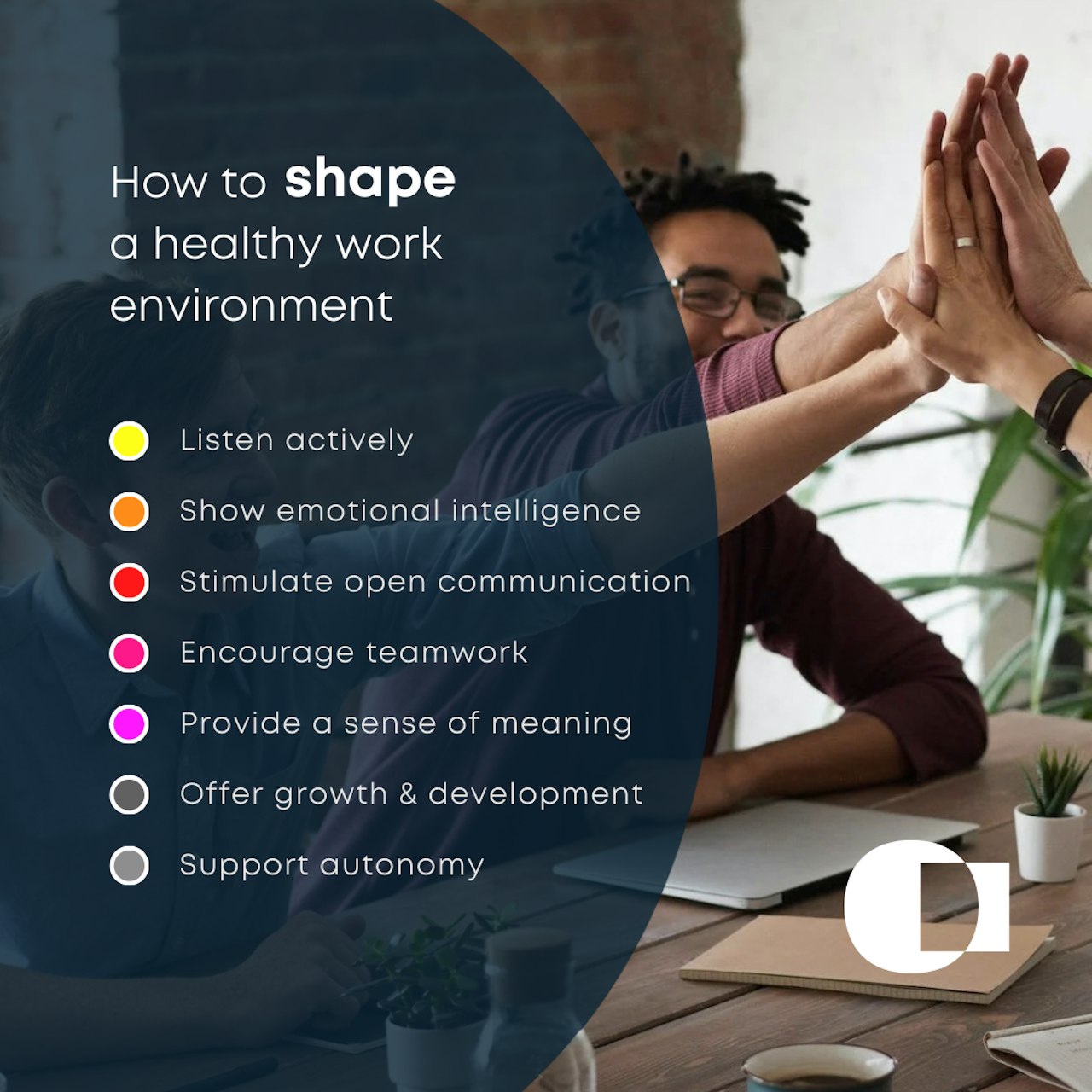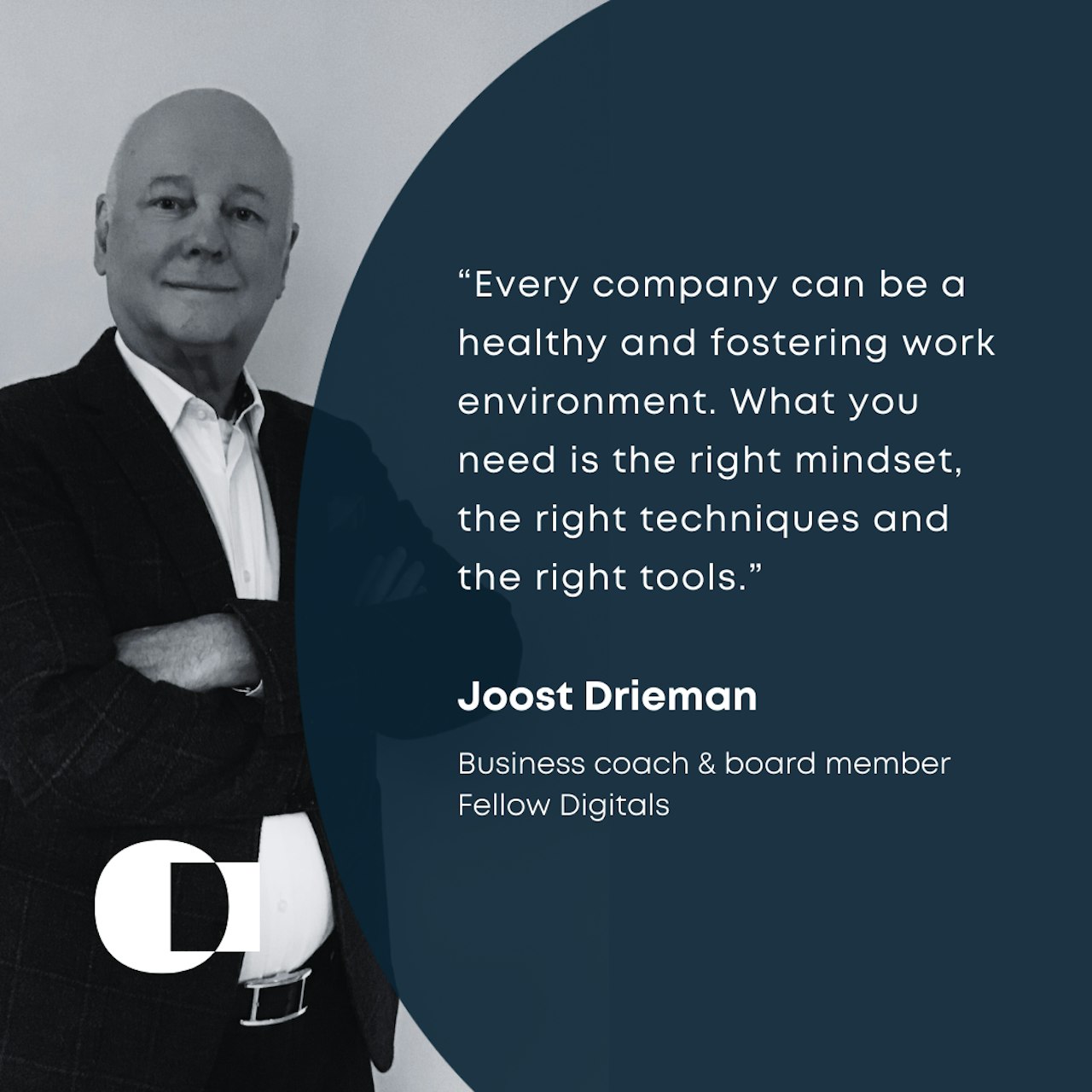7 tips for creating a healthy work environment
Blog | workplace happiness

In our series “Building a Healthy Work Environment,” Joost Drieman, an experienced senior certified coach and business advisor, shares over 35 years of expertise in guiding companies towards thriving work environments. In this episode, Joost shares invaluable insights into fostering a positive workplace culture with these 7 transformative tips.
Managers at a crossroads: Nurturing well-being in uncertain times
In today’s volatile landscape, where changes in politics, economics, and society are constant, businesses face unprecedented challenges. Leaders are under immense pressure to ensure financial stability while prioritizing employee well-being. Amidst this uncertainty, creating a sustainable work environment that fosters psychological resilience becomes crucial. But how do we achieve this? Joost Drieman, senior certified coach, business advisor and board member at Fellow Digitals, shares insights from 35 years of experience.
It’s all about attitude
Top executives play a vital role in shaping workplace attitudes. Employees look to them for guidance during tough times, and for cues on how to react during difficult situations. If you, as a leader, are closed to new ideas, your direct reports will begin to exhibit that same ineffective behavior. The aftermath of ineffective leadership at this level can reverberate throughout the company and have a negative impact on morale.
On the other hand, leaders who recognize the emotional aspects of what is going on in themselves and others will be better able to nurture empathy, create calm and balance, increasing productivity and effectiveness. This attitude promotes constant, transparent communication, which is necessary to make powerful, forward-thinking decisions.
Setting the tone
It is leverage that gives employees the stability and routine needed to unlock their long-term perseverance. However, this only happens when the top executive takes ownership of the transition on a personal level. The following two activities may be difficult to do, but embracing them will help you to drive positive results in your company:
Increase self-awareness. Understand that the difficult situation has a personal impact on you. Long, hard days and difficult decisions can take a personal toll if it affects your co-workers (e.g., working harder, no raise or promotion or getting fired).
Thinking ahead. Good organizations will innovate in these tough times instead of just working harder. By doing that, your company will be ready to move faster when things change in the future. Because how your company will be successful in the future depends on the actions you take today. Given this far-reaching impact, talent needs should always be part of the decision criteria for any change.

Top 7 tips for a healthy work environment
To foster a healthy psychological and emotional perspective in your employees, you need to stimulate a positive work culture. You, as a top executive, can set the tone for the entire company by:
Active listening When you are open to ideas and understand challenges, you create rapport at a time when you need it most. Sticking to your own point of view versus being open to another’s is counterproductive. Keeping an open mind and encouraging diversity of thought is necessary. Your decisions will be better because of it.
Developing emotional intelligence Financial leaders can improve their own emotional intelligence and encourage others to do the same. This includes understanding and managing emotions, showing empathy and developing strong interpersonal relationships.
Stimulating open and transparent communication Be honest and share all information as much as possible. Not just facts and figures, but also challenges and human feelings. This will create a supportive and understanding corporate culture.
Encouraging the importance of teamwork Recognize and celebrate accomplishments. Develop a culture where it is okay to ask for help, but also to work together, mutually respect each other and express feelings.
Emphasizing the purpose and impact of work Help employees link their work to a larger purpose and the impact it has on the company or society. This can promote a sense of meaning, connection and motivation.
Offering growth and development opportunities Professional growth and development can contribute to a sense of purpose and fulfillment among team members. Regularly evaluate goals and provide feedback to help people progress in their careers.
Supporting autonomy Give employees a degree of control over their work and decision-making. Trust their judgment and provide guidance as needed. Tell them , not how! In doing so, you also promote delegation of work. But avoid overburdening team members with excessive tasks. Delegate responsibilities effectively to keep the workload manageable for everyone.
By implementing these strategies – also within the digital workplace context – organizations can create a dynamic and resilient work environment that maximizes employee well-being, collaboration, and productivity, ultimately contributing to long-term success and organizational resilience.
The Golden Nugget
Adopting a creative, innovative, and forward-looking mindset is paramount. Your actions today shape the organization’s future, leaving a lasting impact for years to come. By implementing these strategies, you can spearhead the creation of a resilient work environment that enhances productivity, job satisfaction, and overall well-being.
Practical Tip
Working with a solid digital workplace will help you bring those strategies into practice. A place where information and news is openly exchanged, professional onboarding facilitated and corporate learning possibilities stimulated for all employees.

We love to share our knowledge with you
Related blogs



